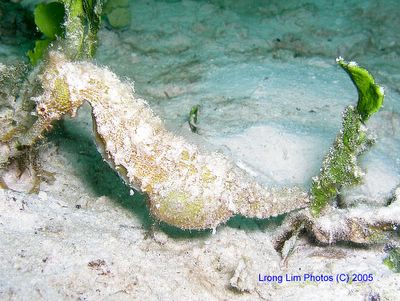
Not too sure about this seahorse specie. It was either a female potbelly seahorse or a (pregnant) male common seahorse.
Most probably, it was the common seahorse. Size was about 20 centimeters.
According to ARKive.org, 'perhaps the most unique and unusual feature of seahorse biology is the fact that it is the male and not the female who becomes pregnant.
When mature, males develop a pouch on the belly, known as the brood pouch. Breeding takes place in spring and summer; the female inserts her ovipositor into the male's pouch and lays her eggs.
The male then fertilises them and they become embedded into the wall of the pouch. The pouch is very similar to the womb found in female mammals; a placental fluid removes waste products and supplies the eggs with oxygen and nutrients.
As pregnancy progresses, this fluid gradually becomes similar to the surrounding seawater, so that when the young seahorses are 'born' the change in salinity is not too great a shock.
After 20 to 28 days of pregnancy the male goes into labour, typically at night when there is a full moon. After hours of thrusting, the miniature seahorses, which look exactly like the adults, are released from the pouch.
The offspring are fully independent after birth and must fend for themselves. They are pelagic in the first stage of life, or hold onto floating debris at the surface with their tail.
Seahorses are ambush predators, and lie in wait for small crustaceans to swim by; they then suck the prey into the tube-like mouth and swallow it whole, as they do not have any teeth.
They do not have many natural predators (except we humans of course), as they rely on their excellent camouflage for protection, and they are unpalatable due to their bony-plated bodies.'

No comments:
Post a Comment